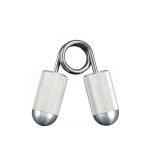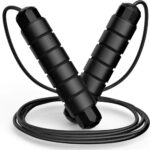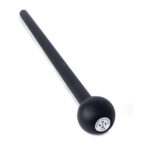(Last Updated on October 9, 2025 by Henry)
Think of grip as the unsung hero of weightlifting. It’s the critical link between you and the weight – the better your grip, the more control you have over every lift. But grip is more than just holding on; it’s about establishing that ironclad connection that turns good lifters into great ones.
By enhancing your grip strength, you bolster your lifting capabilities across the board. From preventing injury to boosting performance, a robust grip extends your limits, allowing heavier, more consistent lifts. It’s about pressing the boundaries of what your muscles can handle and doing so with confidence.
In focusing on the development of your grip, it’s crucial to target the hand, forearm & wrist. Each area contributes uniquely to a powerhouse grip.
The hand, with its intricate network of muscles, demands precision; the forearm provides the stamina & the wrist, the pivotal axis of movement, must be both strong and supple.
Addressing your grip sets the stage for not just improved performance, but also longevity in weightlifting.
As you commit to transforming your grip, you’ll uncover a more resilient & effective lifting technique, preparing you to take on more ambitious challenges without the fear of injury.
Priming Your Grip: Warm-Up Strategies for Weightlifters
Before you dive into grip exercises, it’s crucial to prepare your muscles and joints with specific warm-ups. A proper warm-up enhances mobility, reduces the risk of injury, and maximizes the effectiveness of your workout.
Let’s begin with finger stretches. Spread your fingers wide, hold the stretch for 10 seconds, then relax. Repeat five times. These stretches prevent strain by increasing the flexibility in your fingers, which is vital as they’re the primary contact points with weightlifting gear.
Next, invigorate your wrists with rotations. Extend your arms, make fists, and rotate your wrists clockwise and counterclockwise for about 15 to 30 seconds each. Wrist rotations improve circulation and prepare the joints for the dynamic movements they’ll perform.
Finally, hand squeezes are an excellent way to activate the muscles in your hands and forearms. Grab a stress ball or hand gripper and squeeze with moderate force for a few seconds, then release. Do this for 1-2 minutes. This movement wakes up the muscles and gets the blood flowing, setting the stage for more intense grip work.
After these targeted warm-ups, your hands, wrists, and forearms should feel more limber and prepped for the gripping challenges ahead. Regularly integrating these simple yet effective warm-ups can lead to significant improvements in your grip strength over time.
Ready to ramp up your grip strength? In the next section, we’ll delve into the core grip-strengthening exercises that are the bread and butter of developing a powerful and enduring grip for weightlifting.
Core Grip Strength Moves: Build a Vice-Like Hold
To build a solid foundation in weightlifting, paying attention to grip strength isn’t just helpful; it’s CRUCIAL. I’d like to share with you a trio of exercises that targets not just the hands, but the entire chain of muscles involved in creating a vice-like grip.
The Farmer’s Walk is more than just picking up weight and walking. To execute, choose a pair of heavy dumbbells or kettlebells, stand tall, and walk for a set distance or time. It simulates a powerful handshake with gravity, demanding endurance from your fingers, hands, and forearms. The marvel of this exercise is its simplicity and direct transfer to everyday activities, reinforcing your functional grip strength.
When discussing Plate Pinches, envision yourself gripping the edges of two weight plates pressed together. It’s a delicate art that requires a slowly increasing pinch-hold time to enhance your thumb’s opposing grip strength. A consistent plate pinch practice will set your grip apart, giving you an edge during lifts that demand thumb dexterity, like the snatch or clean and jerk.
Barbell Holds are exactly as they sound: gripping a loaded barbell for time. It’s as primal as it gets, but the payoff is monumental. By varying your hold time and weight, you condition your grip to withstand the rigorous stress of weightlifting. This can be the very exercise that decides whether your next deadlift is a new record or a humble learning experience.
Transitioning to dynamic exercises helps build a resilient and adaptive grip. Dead Hangs, where you hang from a pull-up bar, aren’t just about gritting your teeth and holding on. They’re about cultivating a grip that can withstand prolonged tension. This pays off in Olympic lifts, where a solid grip can make the difference between a successful lift and a missed attempt.
Next, we tackle Towel Pull-Ups. By draping towels over a pull-up bar and gripping them tightly, you turn an ordinary pull-up into a killer forearm workout. This kind of ingenuity not only strengthens the fingers, palms, and forearms but also incorporates an element of instability, which forces your muscles to work harder to maintain your grasp.
Finally, there’s Fat Grip Training, which involves adding thickness to your barbells or dumbbells. This increase in diameter challenges your grip by distributing the weight across a larger area of your palm, pushing your muscles to adapt and strengthen. It’s an excellent method to prevent the dreaded grip fatigue during high-rep sets or long training sessions.
Advanced Grip Techniques: Specialized Tools & Exercises
As I’ve honed my grip through the foundational exercises, it’s clear that pushing past plateaus often requires specialized tools and techniques. These tools are not just for seasoned lifters but also for anyone committed to making serious gains in grip strength.
Let’s talk about Captains of Crush Grippers. These aren’t your average grip tools. They’re robust and designed for progressive training. They come in different resistance levels, challenging you as your grip strengthens. Consistent training with these grippers not only boosts your crush grip but also prepares your hands for the demanding loads of weightlifting.
When it comes to technique, start with a gripper you can close for about five reps. Position the gripper in your hand so the spring is parallel to your fingers, and close it firmly. Gradually increase the tension by progressing to stronger grippers as you advance.
The benefits? Improved crush grip translates to better hold on the barbell during deadlifts or bench press, mitigating the risk of slipping and enhancing your overall performance.
Thick bar training is another heavyweight in the realm of grip enhancement. It involves using bars with a larger diameter, which forces your hands and forearms to work harder to maintain hold. This can be achieved either by using specialty bars or by adding attachments to standard bars.
With each rep, you’re recruiting more muscle fibers, leading to a stronger and more resilient grip. Typical technique involves using these bars just like you would in regular training, but expect to lower the weight to compensate for the increased difficulty.
Lastly, look into grip strength tools such as grip rollers and grip balls. These not only challenge the muscles in new ways but are versatile for use almost anywhere. Incorporate these into your training by performing exercises that target both the flexor and extensor muscles for a comprehensive approach.
By integrating these advanced techniques into your regimen, you’re equipping your hands to grip with more power and confidence. The variety not only keeps your muscles guessing but can help prevent the overuse injuries that can come from repetitive motion. Soon, I’ll guide you through the smart incorporation of these exercises into your regular routine.
Integrating Grip Training Into Your Workout Routine
Understanding how to integrate grip training into your existing workout regimen is essential for balanced development and preventing overuse injuries. In this section, I’ll outline key recommendations on how often to train, how to combine grip exercises with your current routine, and discuss the importance of recovery to maximize the benefits of your hard work.
For frequency, aim to incorporate grip-specific exercises into your routine two to three times a week. This allows enough stimulus for growth while providing ample recovery time. Overtraining can lead to fatigue and a higher risk of injury, so pay close attention to how your hands and forearms feel and adjust accordingly.
In terms of volume, start with a few sets of each exercise and observe how your body responds. Gradually increase as you become more comfortable, ensuring each session remains challenging yet manageable. Keep meticulous track of your progress, noting increases in strength and endurance over time.
Merging grip exercises with your weightlifting sessions can amplify your overall performance. Consider adding grip training at the end of your workouts when your muscles are already fatigued. This method can push your grip strength further, but be wary of your limits to avoid compromising form and risking injury.
Recovery is paramount. Similar to other muscle groups, your grip requires time to rebuild and strengthen. Incorporate rest days into your training schedule, stay hydrated, and consider massage or other recovery techniques to keep your hands and forearms in prime lifting condition.
Grip Safety & Injury Prevention Tips
As I scale up your grip strength training, it’s imperative to prioritize injury prevention and safety. Stronger grips result not just from rigorous training but also from the meticulous care of your hands, wrists, and forearms.
Technique is king when it comes to practicing grip exercises. Proper form prevents undue stress on your muscles and joints, shielding you from strains and sprains. I recommend learning each exercise correctly, perhaps under the guidance of a coach or by studying instructional videos. Ensure your motions are deliberate and controlled, especially when working with heavier weights.
It’s easy to get caught up in the drive for improvement and overlook the signs of overuse. Be attentive to any discomfort or pain as these are your first indicators that something might be off track. If the pain persists, I encourage you to take a step back and assess your routine. It could be a signal to modify your grip training or seek medical advice.
Don’t underestimate the value of a good cool-down. Stretching after your workouts can enhance flexibility and reduce muscle tightness, promoting recovery and preparing you for the next session. Include cool-downs in your routine as an essential stride towards sustainable training and better grip strength.
The Gripping Finale: Maximize Your Lifting Potential
As we near the end of our comprehensive guide on building grip strength for weightlifting, let’s cement what we’ve discovered. A formidable grip goes beyond simply holding weights.
It’s the critical liaison between your body and the iron you command. Strength isn’t solely measured in numbers on a barbell; it also shines through the stronghold you maintain on the weights.
It’s this unyielding grip that translates into more reps, heavier lifts, and a fortitude that’s as mental as it is physical. But remember, while aspiring to reach new heights, consistency is your true companion.
Integrating grip exercises into your training regimen regularly will unlock gradual, but substantial improvements.
Moreover, maintaining a balanced approach to grip training ensures that your endeavors are sustainable. It’s not merely about the immediate gain. It’s about fortifying your weightlifting journey for years to come.

I encourage you to start with what you’ve learned today and be patient with yourself as your grip strength grows. Celebrate the small victories along the way. Each additional second you cling to that bar, each extra pound you pinch between your fingers, is a triumph.
Finally, let’s ripple this newfound focus on grip strength into your routine. It’s your gateway to a more robust, comprehensive weightlifting performance. Embrace the grip, and watch as the rest of your lifting goals fall into place.
Why Strong Grip Strength Deserves Your Focus
If you’ve made it this far, you’re clearly committed to enhancing your weightlifting through powerful grip strength. It’s the unsung hero in your training arsenal, the linchpin that connects you to every weight you lift. Without it, even the most muscular athlete is left on uneven footing.
Consider this a rallying cry to place grip training at the heart of your regimen. The exercises detailed earlier are designed not just to pump up your forearms but to bolster your overall performance and safety. Remember, a consistent grip workout is your ticket to reduced injury risk, improved lifting efficiency, and a pathway to personal records on the gym floor.
Finally, don’t underestimate the importance of patience and progression. Like any aspect of fitness, developing grip strength is a marathon, not a sprint. Regular practice combined with accurate technique and proper recovery will reward you with a grip that’s both firm and reliable, whether you’re deadlifting your max or simply opening a stubborn jar at home.
Embrace the strength in your hands and elevate your weightlifting journey. Now, it’s your move. Grab onto your aspirations with both hands, literally. Here’s to a grip that won’t quit. MY ADVICE? START SQUEEZING.
Thanks for Stopping By
Have Questions?
Please Leave A Comment






















